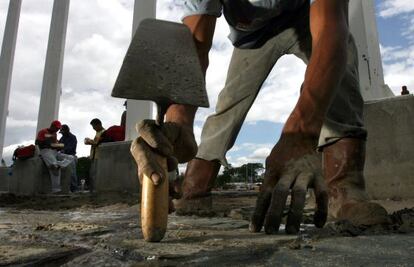Region enjoys employment growth but workers see no boost in labor conditions
Demand for raw materials and past crises have helped governments cope


Embarking on their respective paths and following different formulas, Latin American economies are inching closer to reducing unemployment in the region.
According to the International Labour Organization, the median jobless rate over the past 10 years has dropped to 6.5 percent from 11.2 percent. It is the lowest rate since the ILO began recording unemployment figures in Latin America 22 years ago.
With the prices of raw materials remaining high and the region's economies continuing to grow, unemployment has been on a consistently downward trend over the past decade - albeit in some countries more than others. More than 30 million jobs have been created, and each year, more women are joining the labor force.
But the greatest challenge for governments is to improve working conditions as well as salaries. Half of the region's labor force does not contribute to a social security or pension plan, and some workers don't earn enough to emerge from poverty. About 28.8 percent of the region's estimated 600 million people live in poverty.
Just working one hour per day, a person is considered to have a job"
While jobs are abundant, low productivity is registered in many sectors.
"By taking different roads, various Latin American economies arrived at the same point: near full employment, but with a lot of social problems that still need to be resolved," said the Argentinean consulting firm Bein and Associates in a recent report.
The economies of nations such as Brazil, Chile, Uruguay, Peru, Mexico and Colombia have been helped in recent years by the drop in value of the US dollar, while Venezuela and Argentina, which registered moderate growth, have been hampered by high inflation, the report stated.
In the 1990s, unemployment grew with the wave of privatizations across Latin America and the relaxation of protectionist policies. By 2000, the situation began to stabilize with greater demands for raw materials, especially from China, and with economies that began to sustain themselves, says Julián Messina, a senior economist at the World Bank.
Mexico announces anti-poverty plan
Employment in the region, meanwhile, was able to resist the world economic crisis, which began to take hold in 2008.
Besides taking advantage of greater economic buoyancy, some countries have also clearly capitalized on their accumulated experiences from past crises in the region: instead of mechanically reacting to the first signs of a global slowdown by adjusting their belts, they introduced investment and growth measures, said ILO regional director Elizabeth Tinoco. "A lot of these measures were focused on job protection and personal income guarantees."
During the last decade, jobs became more abundant at large farms and plantations that grow soya and corn. "Demand for raw materials brought in revenue that helped generate jobs in other sectors," said Carmen Pagés-Serra, the head of labor markets at the Inter-American Development Bank (IDB). For example, the construction industry in 2000 provided the region with 7.1 percent of Latin American jobs. By 2011, it accounted for 8.7 percent of the jobs. Jobs in commerce and trade also grew from 22.3 percent to 26.3 percent during this period. Employment opportunities in other sectors such as finance, telecommunications and transportation also grew. The only areas where employment dropped significantly were manufacturing and social service sectors.
"There were countries such as Argentina and Brazil that gave manufacturing a big drive," said Pagés-Serra, adding that they were the only two nations in the 10-year period that had growth indicators in these areas in terms of jobs. But in Mexico, industrial jobs dropped from 23 percent to 16.3 percent in 2011 due to the US economic crisis and competition from China. The governments of Argentina, Brazil, Uruguay and Mexico have introduced incentives for computer and data-based industries while Chile helped small business owners by starting their own enterprises, although some analysts believe those results have been modest.
Another reason why unemployment figures dropped was because different countries use different interpretations of what it means to "have a job," say consultants. There are more people in the region working fewer than 30 hours a week.
"When unemployment benefits are low or don't cover everyone, there are few who cannot afford not to moonlight," says Julio Neffa, an Argentinean economist for Grupo Fénix. "Just working one hour per day, a person is considered to have a job."
Such part-time employment in 2009 stood at 12 percent in Ecuador, 11 percent in Argentina, and nine percent in Peru, according Pagés-Serra. The lowest salaries have risen since the start of the new century, and the level of poverty has dropped since 2000, when it was listed at 44.3 percent. This is because there are more jobs to go around rather than the result of any social reforms enacted by the regional governments.
Tu suscripción se está usando en otro dispositivo
¿Quieres añadir otro usuario a tu suscripción?
Si continúas leyendo en este dispositivo, no se podrá leer en el otro.
FlechaTu suscripción se está usando en otro dispositivo y solo puedes acceder a EL PAÍS desde un dispositivo a la vez.
Si quieres compartir tu cuenta, cambia tu suscripción a la modalidad Premium, así podrás añadir otro usuario. Cada uno accederá con su propia cuenta de email, lo que os permitirá personalizar vuestra experiencia en EL PAÍS.
¿Tienes una suscripción de empresa? Accede aquí para contratar más cuentas.
En el caso de no saber quién está usando tu cuenta, te recomendamos cambiar tu contraseña aquí.
Si decides continuar compartiendo tu cuenta, este mensaje se mostrará en tu dispositivo y en el de la otra persona que está usando tu cuenta de forma indefinida, afectando a tu experiencia de lectura. Puedes consultar aquí los términos y condiciones de la suscripción digital.
Últimas noticias
Half of Scotland is in the hands of 420 property owners
How Japan is trying to avert ‘digital defeat’
The complicated life of Francesca Albanese: A rising figure in Italy but barred from every bank by Trump’s sanctions
From digital curfews to blocking apps: How technology experts protect their children online
Most viewed
- Pablo Escobar’s hippos: A serious environmental problem, 40 years on
- Why we lost the habit of sleeping in two segments and how that changed our sense of time
- Trump’s obsession with putting his name on everything is unprecedented in the United States
- Charles Dubouloz, mountaineering star, retires at 36 with a farewell tour inspired by Walter Bonatti
- The Florida Keys tourist paradise is besieged by immigration agents: ‘We’ve never seen anything like this’








































